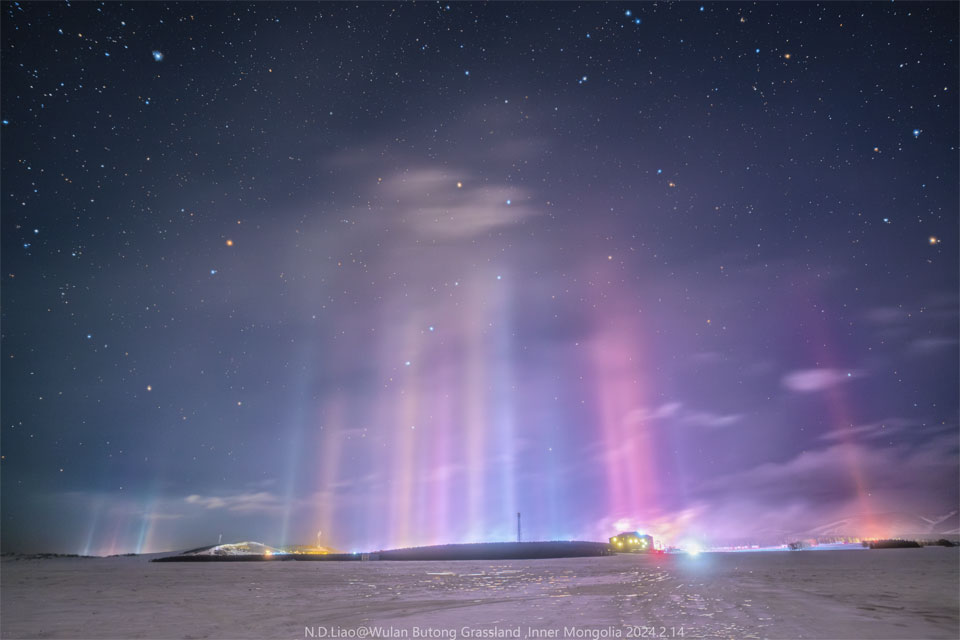
Nombre total de pages vues
04/03/2024
SANTé/MEDECINE - La caméra TEP : voir le cerveau grâce à des traceurs radioactifs

MYSTERES SOUS L'EAU DES LACS - Castor d'Europe l'infatigable bâtisseur

ASTRONOMY - Light Pillars Over Inner Mongolia
2024 March 4
Image Credit & Copyright: N. D. Liao
Explanation: What's happening across that field? Pictured here are not auroras but nearby light pillars, a phenomenon typically much closer. In most places on Earth, a lucky viewer can see a Sun pillar, a column of light appearing to extend up from the Sun caused by flat fluttering ice-crystals reflecting sunlight from the upper atmosphere. Usually, these ice crystals evaporate before reaching the ground. During freezing temperatures, however, flat fluttering ice crystals may form near the ground in a form of light snow sometimes known as a crystal fog. These ice crystals may then reflect ground lights in columns not unlike a Sun pillar. The featured image was taken last month across the Wulan Butong Grasslands in Inner Mongolia, China.
03/03/2024
AUTOMOBILE - INVENTIONS QUI N'ONT JAMAIS VU LE JOUR - Cadre en fonte d'aluminium

ASTRONOMY - A Total Solar Eclipse Close-Up in Real Time
2024 March 3
Music: Flowing Air by Mattia Vlad Morleo
Explanation: How would you feel if the Sun disappeared? Many eclipse watchers across the USA surprised themselves in 2017 with the awe that they felt and the exclamations that they made as the Sun momentarily disappeared behind the Moon. Perhaps expecting just a brief moment of dusk, the spectacle of unusually rapid darkness, breathtakingly bright glowing beads around the Moon's edge, shockingly pink solar prominences, and a strangely detailed corona stretching across the sky caught many a curmudgeon by surprise. Many of these attributes were captured in the featured real-time, three-minute video of 2017's total solar eclipse. The video frames were acquired in Warm Springs, Oregon with equipment specifically designed by Jun Ho Oh to track a close-up of the Sun's periphery during eclipse. As the video ends, the Sun is seen being reborn on the other side of the Moon from where it departed. Next month, on April 8th, a new total solar eclipse will be visible in a thin band across North America.
02/03/2024
ASTRONOMY - Odysseus on the Moon
2024 March 2
Image Credit: Intuitive Machines
Explanation: Methalox rocket engine firing, Odysseus' landing legs absorb first contact with the lunar surface in this wide-angle snapshot from a camera on board the robotic Intuitive Machines Nova-C moon lander. Following the landing on February 22, broken landing legs, visible in the image, ultimately left the lander at rest but tilted. Odysseus' gentle lean into a sloping lunar surface preserved the phone booth-sized lander's ability to operate, collect solar power, and return images and data to Earth. Its exact landing site in the Moon's far south polar region was imaged by NASA's Lunar Reconnaissance Orbiter. Donated by NASA, the American flag seen on the lander's central panel is 1970 Apollo program flight hardware.
01/03/2024
MYSTERES SOUS L'EAU DES LACS - Les algues filamenteuses ou Halloween lacustre

ASTRONOMIE - Eruption solaire exceptionnelle

ASTRONOMY - Odysseus and The Dish
2024 March 1
Image Credit & Copyright: John Sarkissian (ATNF Parkes Radio Observatory)
Explanation: Murriyang, the CSIRO’s Parkes radio telescope points toward a nearly Full Moon in this image from New South Wales, Australia, planet Earth. Bathed in moonlight, the 64 meter dish is receiving weak radio signals from Odysseus, following the robotic lander's February 22 touch down some 300 kilometers north of the Moon's south pole. The landing of Odysseus represents the first U.S. landing on the Moon since the Apollo 17 mission in 1972. Odysseus' tilted orientation on the lunar surface prevents its high-gain antenna from pointing toward Earth. But the sensitivity of the large, steerable Parkes dish significantly improved the reception of data from the experiments delivered to the lunar surface by the robotic moon lander. Of course the Parkes Radio Telescope dish became famous for its superior lunar television reception during the Apollo 11 mission in 1969, allowing denizens of planet Earth to watch the first moonwalk.
29/02/2024
AUTOMOBILE - INVENTIONS QUI N'ONT JAMAIS VU LE JOUR - Pare-brise arrière rabattables - Ford Heritage Vault

ASTRONOMY - STEVE: A Glowing River over France
2024 October 28 STEVE: A Glowing River over France Credit & Copyright: Louis LEROUX-GÉRÉ Explanation: Sometimes a river of hot gas flo...

-
2022 September 26 All the Water on Planet Earth Illustration Credit: Jack Cook, Adam Nieman, Woods Hole Oceanographic Institution ; Data ...
-
2025 May 11 The Surface of Venus from Venera 14 Image Credit: Soviet Planetary Exploration Program , Venera 14 ; Processing & Copyri...

